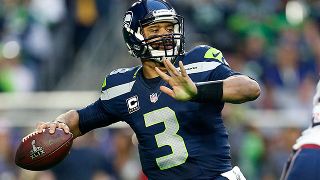The recent July 15 deadline for franchise players to sign long-term deals wasn't a historical moment, but it was an important one for players.
The four long-term deals livened up what was becoming a stagnant market for re-signings. Dez Bryant and Demaryius Thomas took the top-tier wide receiver market to $14 million per year (Calvin Johnson's $16-million-per-year contract notwithstanding). Justin Houston made a monumental jump with his six-year, $101-million deal. And Stephen Gostkowski's deal for $4.3 million annually created a new landmark for kickers.
Two majors factors enabled these deals to get done. First, the rapidly increasing franchise tag numbers helped Bryant and Thomas shatter the previous ceiling for wide receiver contracts ($11-12 million per year). The other factor? The stellar 2011 draft -- which has 12 Pro Bowlers among the top 16 picks and 23 total Pro Bowlers -- has helped drive up the market in a big way. Richard Sherman, a fifth-round pick in 2011, helped set the market for elite cornerbacks at $14 million per year, and Patrick Peterson, a first-rounder from that class, topped him at $14.1 million.
In fact, 14 of the current 62 players who make at least $10 million per year came from the 2011 class, and at least seven of the 11 players playing out their fifth-year options should eventually get deals in that same range. (That doesn't include 2011 undrafted linebacker Junior Gallette, who signed a four-year, $41.5 million deal.)
These figures are significant because the 2011 class was the first one to endure the rookie wage scale -- and the first to prove that big-time money is on the horizon for those who outperform their deals.
Let's review a few potential ripple effects from these recent signings, including how some yet-to-be-extended 2011 draftees will be impacted.
1. Houston, we may have a problem. Houston's $101 million deal might be the most important contract signed this year. Clay Matthews of the Green Bay Packers had been the highest paid 3-4 outside linebacker at $13.2 million a year. Houston was able to convince the Chiefs to treat him like a play-making pass-rusher instead of just a 3-4 OLB. That concession allowed Houston to top Mario Williams' $16-million-per-year deal and J.J. Watt's six-year, $100 million contract. While that's great for Houston, it could make it tougher for the Denver Broncos and San Francisco 49ers to extend the contracts of Von Miller (second overall pick in 2011) and Aldon Smith (seventh overall pick), who can make similar arguments. You also wonder if 3-4 outside linebackers making quarterback money will slow down the escalation of teams switching to a 3-4 defense. Teams who hit on 3-4 outside linebackers might not be able to keep them. A few years ago, Terrell Suggs of the Baltimore Ravens had to file a grievance when he was tagged as a linebacker following a season in which he claimed more than 50 percent of his snaps came along the defensive line rushing the quarterback. Houston used that argument to his benefit -- and may have changed the way 3-4 OLBs are paid for good.
2. A.J. Green and Julio Jones are in line for big-time paydays. The five-year, $70-million deals signed by Bryant and Thomas will probably be topped by Green (fourth overall pick in 2011) and Jones (sixth overall). The question is when? Thomas and Bryant are getting their deals headed in to their sixth seasons. If Green and Jones both signed, say, four-year extensions before this season (their fifth in the league), they would be in line for another contract with one year less mileage than Bryant or Thomas. That could benefit them in the long run; recent studies have shown that receivers start to slow down in their seventh or eighth seasons.
3. Jets impacted by 3-4 DE market. Watt is -- and will be for the foreseeable future -- an outlier at 3-4 DE. His $16.6-million-per-year salary is massive, but that's OK: Players voted him as the best player in the league this offseason. The secondary market 3-4 DEs has spiked too. Cameron Jordan extended his deal for $11 million per year; Corey Luiget received $10.25 million annually from the San Diego Chargers; and on Friday, Cameron Heyward received $10.4 million per year in new money on a five-year extension from the Pittsburgh Steelers. Imagine the impact on the New York Jets, who have three great 3-4 defensive ends -- Muhammad Wilkerson (30th overall pick in 2011), Sheldon Richardson and rookie Leonard Williams. Wilkerson is in his fifth-year option and Richardson is up in 2017. It's highly unlikely they'll be able to afford both.
4. Marcell Dareus will play a big part in the defensive tackle market. Dareus won't make anywhere close to Ndamukong Suh money ($19.062 million per year), but he might be able to top Gerald McCoy's $13.6 million annual price tag. The fifth-year option on Dareus, the third overall pick in 2011, is worth more than $11 million a year, which means the Bills already have four defensive linemen averaging more than $9 million per year.
From the inbox
Q: NFL owners don't want to fully guarantee contracts because of the high risk of injury, I get that. But to me that's exactly why NFL contracts should be guaranteed, and I'm sure players feel the same way. My question is can't a compromise be made where contracts are fully guaranteed, but players who are cut have their money taken out of the salary cap equation?
Erik in Virginia
A: The owners will never agree to a system of fully guaranteed contracts because of the injury factor. Teams go into every season anticipating at least 10 players will be on the injured reserve list. Those 10 players have to be replaced on the roster and count against the cap. If players with big salaries suffer career-ending injuries, then the pool of dead money against a team's cap would paralyze them. Unless they increase the percentage of revenue that goes to players, they can't put the guaranteed pay for released players into a different category because it would give more than 47 percent of the revenue going to the players. The players and the union would go for it, but the owners like pocketing the 53 percent of the profits.
Q: How can the Broncos and Cowboys argue that there was no collusion when they arrived at nearly identical contracts for their receivers within hours of each other? Seems highly coincidental.
Daniel in Minneapolis, Minnesota
A: Where is the proof? And, if there was collusion, it would've likely been on the agent side, which is not against the rules. Doug France did the Thomas deal. He is joining CAA, the company that handled Dez Bryant's contract. Bryant started settling on his deal on the eve of the franchise deadline. I'm sure the agents shared the numbers and knew where the market was going. Thomas had a choice: He could take $14 million per year or play out the season at $12.8 million.
Q: I would like to know if there are any NFL rules that prevent an outside team from bidding on a franchised player to drive up the contract price for the team that franchised the player. A perfect example is if Russell Wilson is franchised by the Seahawks, but the Rams offer him a deal (plus the two first rounders) just to drive up the Seahawks' price.
Sean in Seattle, Washington
A: There is no rule against it. Any team that would bid on a franchised Wilson would present the Seahawks with two options: Take the two first round picks or match the offer within seven days. The problem for the team doing the initial offer (the Rams, in this hypothetical situation) is that it ties up significant cap room for seven days. Plus, there's the issue of actually giving up two highly valuable picks if the Seahawks choose not to match. It can be done, but odds are against it.

Q: I was intrigued by the question you posted regarding a developmental league and how it could generate fan support by team affiliation. I agree with you that 32 developmental teams will not work, just as 16 teams, each shared by 2 teams will not. Tell me what you think about this: An eight-team developmental league, with each team belonging to teams in a specific division. Team locations and player ownership could be worked out, but I see it as a positive way to foster fan affiliation with the "minor leagues."
Michael in Liberty Township, Ohio
A: I like that idea a lot. Coaches might have a problem having their players mingle with competitors in the division, but an eight-team developmental league makes a lot of sense. How about this tweak: If too many coaches don't like divisional rosters, why not pair four non-divisional teams from the same conference? They could set up a league with annual changes and match teams up that don't play each other that season. Regardless of the details, the most important thing is getting some kind of developmental league. It's long overdue.
Q: Try to follow me here: How does Justin Houston's $101 million deal complicate the Seahawks' contract negotiations with Russell Wilson assuming they will have to pay Bobby Wagner, another game changing LB, next year? Or does that not change anything?
Jeremy in Seattle, Washington
A: Doesn't change a thing. If Wilson wants to take a long-term deal, he could make more than $21 million a year, way over what Houston received. Wagner is a middle linebacker who doesn't sack the quarterback. Currently, that market is at $9.6 million per year. My guess is Wagner gets $9.5 million to $10 million annually.
Q: Can there be some sort of pre-contract deal for NFL players stating that "if you win Super Bowl 50, you are are guaranteed to be the up-to-date highest paid player in the NFL"?
Brandon in Puyallup, Washington
A: A team could suggest it but there aren't many agents who might accept such talk because there are no guarantees and nothing tangible to accept. What if the player suffers an injury and the team doesn't think he's going to be the same player after the injury? The agent can't come back and say he had a real offer at that number. A third party can't become financially involved. All terms have to fit into a collectively bargained contract form that is reported to the league. Any additional pay has to be added as a written addendum and counted against the cap.
Q: I've always wondered why the NFL rewards players for running out of bounds. They avoid contact and get clock management benefits. What's the rationale for this in the NFL?
David in Sydney, Australia
A: It doesn't happen as much as you would think. Sure, it stops the game, but it's not as bad as a flop in soccer or basketball. However, it does leave that player up for criticism among his peers for not being tough enough to stay in bounds and take the hit.


